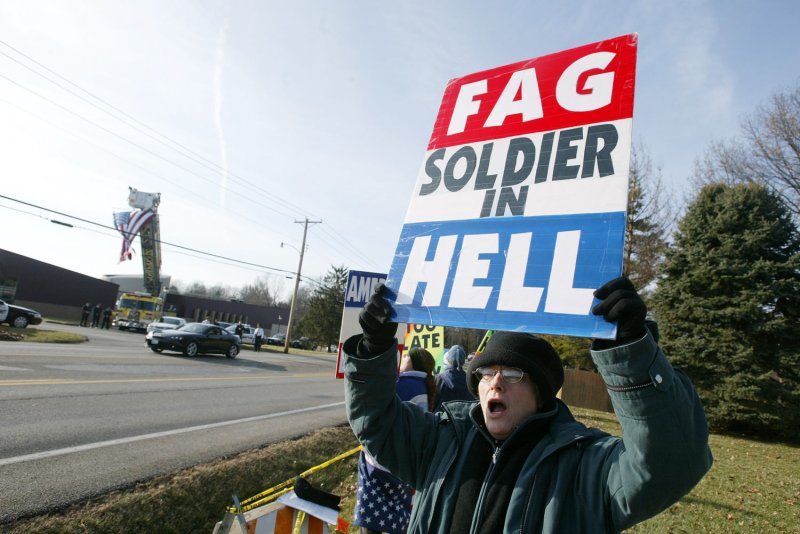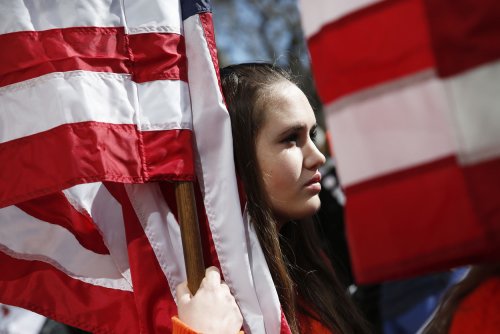A protester with the Westboro Baptist Church of Topeka, KS, chants as the funeral procession for U.S. Army Pvt. Peter Navarro pulls up to the St. Clare of Assisi Catholic Church in Ellisville, Mo on December 23, 2005. The group led by the Pastor Fred Phelps. protests at the funerals of U.S. servicemen and women claiming that God is punishing those that fight in the Iraq war. Navarro was killed by a roadside bomb on December 13 in Iraq. (UPI Photo/Bill Greenblatt) |
License Photo
WASHINGTON, Oct. 17 (UPI) -- He's the pastor most Americans probably love to hate. Like a vulture, the Rev. Fred Phelps Sr. swoops down on families when they are most vulnerable -- when they are trying to bury a child killed in the line of duty in the U.S. military.
Like another pastor with a tiny congregation -- the Rev. Terry Jones of the Dove Outreach Center in Gainesville, Fla., who threatened to burn a number of Korans to protest the planned Islamic center near Ground Zero in Manhattan -- Phelps has commanded media attention far beyond his actual influence by engaging in outrageous behavior.
Phelps and the members of his Westboro Baptist Church of Topeka, Kan., show up at the funerals of service members to protest what they consider the military's toleration of homosexuality, and the toleration of homosexuality in the United States. They darkly warn of the anger of a just God and say dead soldiers are the evidence of that anger.
They don't target gay soldiers, just soldiers. They've been protesting funerals since 2005.
In 2006, Phelps and others picketed the Maryland funeral of Matthew Snyder, a 20-year-old U.S. Marine killed in the line of duty in Iraq. The protesters carried signs saying, among other things, "Thank God for dead soldiers," "God hates fags," "Fag troops," "Pope in hell" and "You're going to hell." They also posted an "epic" on their Web site titled, "The Burden of Marine Lance Cpl. Matthew A. Snyder."
Snyder's shocked family sued and won a jury verdict. A federal judge upheld the verdict and $5 million in damages for emotional distress, but a federal appeals court reversed, saying the protesters were using "rhetorical hyperbole" absolutely protected by the First Amendment.
In argument Oct. 6, the U.S. Supreme Court justices didn't even bother to hide their disdain for the pastor's activities. Comments reported from the bench were devastating.
Liberal Justice Ruth Bader Ginsburg said: "This is a case about exploiting a private family's grief. Why should the First Amendment tolerate that?" Fellow liberal Justice Elena Kagan, while noting that the demonstrators observed the law, said they were "glomming" onto a private family's funeral. Conservative Justices Samuel Alito and Antonin Scalia recalled ugly protests against soldiers who had died in the Vietnam War.
Another conservative, Chief Justice John Roberts, repeatedly suggested the Westboro Baptist funeral protesters had singled out the dead soldier's family and the funeral to achieve "maximum publicity," not to discuss the morality of the war.
Roberts also was openly skeptical of the church's claim that "it is not an issue of seeking maximum publicity; it was using a public platform to bring a public message."
In sum, it looked like the justices would give him short shrift.
Which will make it all the more surprising if, as seems likely, the pastor wins his case, or at least part of it, when the Supreme Court rules sometime in the next few months.
Historically, the Supreme Court has always used "strict scrutiny" -- the highest standard of review -- when weighing actions that interfere with freedom of speech. The action must further a "compelling" governmental interest, must be pared down to affect the smallest amount of speech possible and must be the "least restrictive" method of interfering with free speech.
Plus, across the decades, the justices have made plain that free speech trumps public outrage. In 1989's Texas vs. Johnson, a famous precedent, a 5-4 Supreme Court majority struck down the state's ban on flag burning -- two of the conservatives in that narrow majority, Scalia and Justice Anthony Kennedy, are still on the court.
Writing for the majority in Johnson, the late Justice William Brennan made it plain that the First Amendment would not give way to public opinion.
"If there is a bedrock principle underlying the First Amendment," Brennan wrote, "it is that the government may not prohibit the expression of an idea simply because society finds the idea itself offensive or disagreeable."
Just as revealing is a series of Supreme Court precedents dealing with aggressive anti-abortion protesters at women's clinics.
In 1993's Bray vs. Alexandria Woman's Health Clinic, a group of clinics and their supporters sued to keep protesters away from their facilities. A federal judge ruled that the clinics violated federal civil rights law, but a 6-3 Supreme Court decision reversed, saying you could protest abortion without discriminating against women.
In 1997's Madsen vs. Women's Health Center, a Melbourne, Fla., doctor said patients had to run a protesters' gantlet to enter the clinic. The protests made the patients show "a higher level of anxiety and hypertension, causing those patients to need a higher level of sedation to undergo the surgical procedures, thereby increasing the risk associated with such procedures. ... The noise produced by the protesters could be heard within the clinic, causing stress in the patients both during surgical procedures and while recuperating in the recovery rooms," the Supreme Court opinion said. "And those patients who turned away because of the crowd to return at a later date, the doctor testified, increased their health risks by reason of the delay.
"Doctors and clinic workers, in turn, were not immune even in their homes. (Protesters) picketed in front of clinic employees' residences; shouted at passersby; rang the doorbells of neighbors and provided literature identifying the particular clinic employee as a 'baby killer,'" the opinion said. "Occasionally, the protesters would confront minor children of clinic employees who were home alone."
The 7-2 ruling dealt with the elements of a judge's injunction, and said a 36-foot buffer zone keep protest away from one side of the clinic was legal, but a buffer zone on the other side, one that didn't have to be crossed to enter the clinic, was not. The decision also struck down a ban on signs that could be interpreted as threatening.
In addition, a 300-foot "no approach" zone around the clinic was found too broad.
In 1997's Schenck vs. Pro-choice Network of Western New York, the high court ruled 8-1 that "fixed" buffer zones protecting clinic patients were legal, but "floating buffer zones" that moved with clinic patients violated the First Amendment.
The behavior that evoked a judge's order setting up the buffer zones was typical.
The Supreme Court opinion said the clinics "were subjected to numerous large scale blockades in which protesters would march, stand, kneel, sit, or lie in parking lot driveways and in doorways. This conduct blocked or hindered cars from entering clinic parking lots, and patients, doctors, nurses and other clinic employees from entering the clinics."
In addition, "smaller groups of protesters consistently attempted to stop or disrupt clinic operations. Protesters trespassed onto clinic parking lots and even entered the clinics themselves. Those trespassers who remained outside the clinics crowded around cars or milled around doorways and driveway entrances to block or hinder access to the clinics. Protesters sometimes threw themselves on top of the hoods of cars or crowded around cars as they attempted to turn into parking lot driveways."
Other protesters entered clinic property, handing out literature and talking to people entering the clinics.
"Sometimes protesters used more aggressive techniques, with varying levels of belligerence: getting very close to women entering the clinics and shouting in their faces; surrounding, crowding, and yelling at women entering the clinics; or jostling, grabbing, pushing, and shoving women as they attempted to enter the clinics," the opinion said. "Male and female clinic volunteers who attempted to escort patients past protesters into the clinics were sometimes elbowed, grabbed or spit on."
Outside the clinics, protesters calling themselves "sidewalk counselors" would walk alongside "targeted women headed toward the clinics, handing them literature and talking to them in an attempt to persuade them not to get an abortion," the opinion said. "Unfortunately, if the women continued toward the clinics and did not respond positively to the counselors, such peaceful efforts at persuasion often devolved into 'in your face' yelling, and sometimes into pushing, shoving and grabbing. Men who accompanied women attempting to enter the clinics often became upset by the aggressive sidewalk counseling and sometimes had to be restrained (not always successfully) from fighting with the counselors."
What linked all of the abortion protest cases was not the content or tone of the protest. In each case, the Supreme Court tinkered with a judge's order trying to protect patients, but did not really address the propriety of the demonstrations.
The First Amendment, as the saying goes, has long legs.















